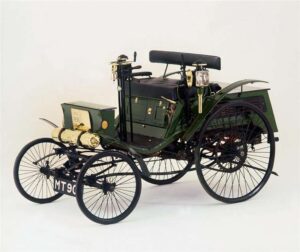Walter Arnold has the distinction of being the first person in the UK to be fined for speeding, after being caught driving through the village of Paddock Wood in Kent at 8 mph (13 km/h) on 28 January 1896.[2] Under the provisions of the Locomotive Act of 1865,[a]Powered passenger vehicles were at the time known as light locomotives, as they were invariably powered by steam. Gottlieb Daimler’s first patents for an internal combustion engine suitable for use in a motor vehicle date from 1884, but it was not until 1889 that his engines began to be produced in any great quantity.[3] commonly known as the Red Flag Act, the speed limit was 4 mph (6 km/h) in the country, reduced to 2 mph in built-up areas.[4]
Arnold was spotted by a local policeman who pursued him on his bicycle, finally catching up with him after a 5-mile (8 km) chase.[5] Arnold appeared before a local magistrate on 30 January, facing four charges in contravention of the Locomotive ActsThe Locomotive Acts of 1861, 1865 and 1878 set the United Kingdom's first speed limits for road-going vehicles; powered passenger vehicles were at the time known as light locomotives, as they were invariably powered by steam.:[6]
- Using a locomotive without a horse on a public road
- Allowing said locomotive to be operated by fewer than three persons
- Travelling at a greater rate than two miles per hour
- Failing to clearly display his name and address on the locomotive
Arnold was found guilty on all counts and fined a total of £4 7s, equivalent to about about £535 as at 2021,[2][b]Calculated using the retail price index.[7] having rejected the alternative offer of seven days hard labour.[1] On the charge of speeding, he was fined one shilling plus nine shillings costs, equivalent to about £62 as at 2021.[6][c]Calculated using the retail price index.[7]
Arnold’s “daredevil ride” down Paddock Wood High Street may have been a publicity stunt, intended to promote his own company, the Arnold Motor Carriage Company, which began to market the Arnold Motor Carriage – a locally built variant of the Benz design – shortly after the trial.[2] The company was short-lived, operating only from 1896 until 1898, but of the dozen or so vehicles believed to have been built in that time, two are known to have survived.[8]
Notes
| a | Powered passenger vehicles were at the time known as light locomotives, as they were invariably powered by steam. Gottlieb Daimler’s first patents for an internal combustion engine suitable for use in a motor vehicle date from 1884, but it was not until 1889 that his engines began to be produced in any great quantity.[3] |
|---|---|
| b, c | Calculated using the retail price index.[7] |

